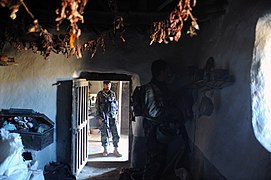Qalat



Qalat, qal'at, qal‘a o kalata son formas de transcribir en alfabeto latino las palabras persa[1] y árabe (قلعة) que significan "lugar fortificado",[2] muy utilizadas en topónimos (como ocurre también con qasr -"alcázar"- o qarya -"alquería"-).
Los qalat pueden ser verdaderos castillos, como Rumkale (Qal'at al-Rum -"fortaleza de los bizantinos"-),[3] o simples lugares rodeados de una tapia de adobe, como ocurre en muchos lugares de Asia suroccidental. El término se utiliza a lo largo del mundo islámico para cualquier tipo de fortaleza.[4] También en lugares de pasado islámico, como Sicilia (Calatafimi, Calatamauro, Calatrasi, Caltabellotta)[5] o España (Calatañazor, Calatrava, Calalberche, Calatayud, Calatorao, Calasparra, Calafell, Calanda, Calamocha, o las numerosas Alcalá).
-
El castillo de Alcalá de Guadaíra.
En muchas zonas tribales de Irán, Afganistán y Pakistán, donde perviven prácticas premodernas de edificación, el qalat sigue siendo el alojamiento habitual de la familia extensa (multigeneracional), y se puede construir con gran rapidez, en una sola estación, a pesar de la gran extensión que abarca (varios acres). Suelen incluir torres en las esquinas o zonas apropiadas para una mayor defensa, aunque la mayor parte solo tienen el circuito de muralla. Los cimientos pueden ser de piedra o ladrillo, pero los muros (que llegan a medir docenas de pies) se levantan habitualmente de adobes, en hiladas que se secan a tiempo de recibir sobre ellas la siguiente hilada.
-
Qalat, en la provincia de Kandahar.
-
Interior de una vivienda de tipo qalat en el distrito Dand Patan (Afganistán)
Véase también[editar]
- Al-Qal'a de Beni Hammad o Qalaat Beni Hammad (en árabe: قلعة بني حماد), yacimiento arqueológico, lugar Patrimonio de la Humanidad de la Unesco, en Argelia
- Qala, circunscripción territorial de Malta
- Qal'at Ja'bar (en árabe: قلعة جعبر), castillo en Siria
- Ciudadela de Saladino o Qal’at Salah El-Din, en Siria
- Qal'at Ibn Ma'n, en Palmira (Siria)
- Ciudadela de Damasco (قلعة دمشق: Qala'at Dimashq), en Siria
- Castillo Chmémis (قلعة شميميس Qalaat Chmémiss), en Siria
- Fortaleza de Nimrod o Qala'at al-Subeiba ("Castillo de la gran roca"), en los altos del Golán
- Castillo de Montfort, Montfort (Israel), Mons Fortis, Starkenberg o Qalaat al-Qarn, antiguo Reino de Jerusalén
- Castillo de Ajlun, Qala'at Ajlun o Qala'at ar Rabad, en Jordania
- Ciudadela de Kirkuk (en árabe : قلعة كركوك, Qal’at Karkuk), en Irak
- Qal'at al-Bahrain, antiguo puerto y capital de Dilmun, en Baréin
- Qalat (Zabul), ciudad de Afganistán
- Qil Qal'eh o Qil Qala, ciudad de Afganistán en la provincia de Bāmiyān
- Eslām Qalʿeh, Eslam Qala o Islam Qala, ciudad de Afganistán
- Qal'eh-ye Panjeh o Qala Panja, ciudad y distrito de Afganistán en la provincia de Badahšan
- Qal'eh-ye Now, Qala i Naw o Qala-e-naw (en pastún : قلعه نو), capital de la provincia afgana de Bādgīs
- Batalla de Qala-i-Jangi (25 de noviembre - 1 de diciembre de 2001), en el Norte de Afganistán
- Batalla de Musa Qala, Qaleh o Qal'eh (7 de diciembre de 2007), en el Sur de Afganistán
Referencias[editar]
- ↑ For the derivation of the Arabic term from the Persian, see Leslau, Wolf (1987) Comparative dictionary of Geʻez (Classical Ethiopic): Geʻez-English, English-Geʻez, with an index of the Semitic roots Otto Harrassowitz Verlag, Wiesbaden, Germany, page 426, ISBN 978-3-447-02592-8, citing Fraenkel, Siegmund (1886) Die Aramäischen Fremdwörter im Arabischen (The Aramaic Loanwords in Arabic) E.J. Brill, Leiden, The Netherlands, page 237, OCLC 750560476, in German, reproduced from original in 1962 by Georg Olms, Hildesheim, Germany, OCLC 476894716, and again in 1982, ISBN 978-3-487-00319-1 and Belardi, Walter (1959) "Arabo قلعة qal‘a" Annali dell'Istituto Universitario Orientale di Napoli - Sezione Linguistica 1: pp. 147–150
- ↑ Steingass, Francis Joseph (1993) Arabic-English Dictionary Asian Educational Services, New Delhi, page 853, ISBN 978-81-206-0855-9
- ↑ Reuven Amitai-Preiss (1995), Mongols and Mamluks: The Mamluk-Īlkhānid War, 1260-1281, pp. 179–225. Cambridge University Press, ISBN 0-521-46226-6. Fuente citada en Rumkale
- ↑ Belardi, Walter (1959) "Arabo قلعة qal‘a" Annali dell'Istituto Universitario Orientale di Napoli - Sezione Linguistica 1: pp. 147–150
- ↑ Influsso arabo: L’elemento arabo è ben attestato, soprattutto in Sicilia, a testimonianza di un dominio, quello saraceno, che durò dall’inizio del IX fino alle soglie del XII secolo. Con il toponimo generico qal‘a (‘cittadella’, ‘fortezza’) abbiamo per esempio Calatafimi, Calatamauro (ovvero ‘la rocca del Moro’), Calatrasi (‘la rocca del tessitore’), Caltabellotta (‘la rocca delle querce’). (Arab influence: The Arab element is well attested, especially in Sicily, evidence of the Saracen rule beginning in the ninth and lasting until the beginning of the twelfth century. From the generic name Qal'a ('citadel', 'fortress') we have, for example: Calatafimi, Calatamauro (i.e. 'the stronghold of the Moor'), Calatrasi ('the fortress of the weaver'), Caltabellotta ('the fortress of the oak trees').) Bentsik, R. "Tracce" ("Traces") "Intercultural Dialogue European Radio Campaign" Archivado el 4 de marzo de 2016 en Wayback Machine. page 61, www.tatapume.org; see also Pellegrini, Giovan Battista (1974) "Attraverso la toponomastica urbana medievale in Italia" ("Through the medieval urban toponymy in Italy") pp. 401–499 In Centro italiano di studi sull'alto Medioevo (1974) Topografia urbana e vita cittadina nell'alto Medioevo in Occidente, 26 aprile-1 maggio 1973 (Conference publication) Presso la sede del Centro, Spoleto, Italy, volume 2, page 415, OCLC 1857092
Bibliografía[editar]
- Kennedy, Hugh N. (2006) Muslim Military Architecture in Greater Syria Brill, Leiden, ISBN 90-04-14713-6
- Facey, William (1997) Back to Earth: Adobe Building in Saudi Arabia Al-Turath in association with the London Centre of Arab Studies, London, ISBN 1-900404-13-3
- Bing, Judith et al. (1996) Architectural Elements of Traditional Settlements International Association for the Study of Traditional Environments, Berkeley, California, OCLC 37475487
- Szabo, Albert and Barfield, Thomas J. (1991) Afghanistan: An Atlas of Indigenous Domestic Architecture University of Texas Press, Austin, Texas, ISBN 0-292-70419-4
- Hallet, Stanley Ira and Samizay, Rafi (1980) Traditional Architecture of Afghanistan Garland STPM Press, New York, ISBN 0-8240-7059-3
- Mumtaz, Kamil Khan (1983) Traditional Forms of Rural Habitat in Pakistan UNESCO, Paris, OCLC 10606333








